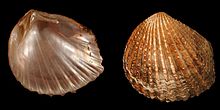
Bivalvia, in previous centuries referred to as the Lamellibranchiata and Pelecypoda, is a class of marine and freshwater molluscs that have laterally compressed bodies enclosed by a shell consisting of two hinged parts. Bivalves as a group have no head and they lack some usual molluscan organs like the radula and the odontophore. They include the clams, oysters, cockles, mussels, scallops, and numerous other families that live in saltwater, as well as a number of families that live in freshwater. The majority are filter feeders. The gills have evolved into ctenidia, specialised organs for feeding and breathing. Most bivalves bury themselves in sediment where they are relatively safe from predation. Others lie on the sea floor or attach themselves to rocks or other hard surfaces. Some bivalves, such as the scallops and file shells, can swim. The shipworms bore into wood, clay, or stone and live inside these substances.

The Veneridae or venerideees, common name: venus clams, are a very large family of minute to large, saltwater clams, marine bivalve molluscs. Over 500 living species of venerid bivalves are known, most of which are edible, and many of which are exploited as food sources.

Palaeoheterodonta is a subclass of bivalve molluscs. It contains the extant orders Unionida and Trigoniida. They are distinguished by having the two halves of the shell be of equal size and shape, but by having the hinge teeth be in a single row, rather than separated into two groups, as they are in the clams and cockles.

Trigonioidea is superfamily of medium-sized saltwater clams, marine bivalve molluscs. Within the fossil record the occurrence of this superfamily is widespread, ranging from the Devonian Period to Recent.

Trigoniidae is a taxonomic family of saltwater clams, marine bivalve mollusks in the superfamily Trigonioidea. There is only one living genus, Neotrigonia, but in the geological past this family was well represented, widespread and common. The shells of species in this family are morphologically unusual, with very elaborate hinge teeth, and the exterior of the shell is highly ornamented.

Corbicula is a genus of freshwater and brackish water clams, aquatic bivalve mollusks in the family Cyrenidae, the basket clams. The genus name is the New Latin diminutive of Latin corbis, a basket, referring to the shape and ribs of the shell. In many Asian countries, these clams are used as ingredients for soup. In South Korea, there is popular soup made of these species of clams known as 재첩국 (jaechup-guk).

Mactridae, common name the trough shells or duck clams, is a family of saltwater clams, marine bivalve mollusks in the order Venerida.

The Plicatulidae are a family of saltwater clams, marine bivalve mollusks, known commonly as kitten's paws or kittenpaws. These bivalves are related to oysters and scallops. The family has a single living genus, Plicatula, with a second, Harpax known from fossils.
A mollusc valve is each articulating part of the shell of a mollusc. Each part is known as a valve or in the case of chitons, a "plate". Members of two classes of molluscs, the Bivalvia (clams) and the Polyplacophora (chitons), have valves.

Tridacninae, common name, the giant clams, is a taxonomic subfamily of very large saltwater clams, marine bivalve molluscs in the family Cardiidae, the cockles.

Isognomon is a genus of marine bivalve mollusks which is related to the pearl oysters.
Solemya velum, the Atlantic awning clam, is a species of marine bivalve mollusc in the family Solemyidae, the awning clams. This species is found along the eastern coast of North America, from Nova Scotia to Florida and inhabits subtidal sediments with high organic matter (OM) content and low Oxygen, such as salt ponds, salt marshes, and sewage outfalls.

Hiatella is a genus of small saltwater clams, marine bivalve molluscs in the family Hiatellidae.

Trigoniida is an order of medium-sized saltwater clams, marine bivalve molluscs. Within the fossil record the occurrence of this order is widespread, ranging from the Devonian Period to Recent.

Trichomya is a monotypic genus of marine bivalve molluscs in the family Mytilidae, the mussels. The only species is Trichomya hirsuta which is endemic to southern and eastern Australia. Its common names include the hairy mussel, the greenling and the kelp greenling.

Glycymeris, common name the bittersweet clams, is a genus of saltwater clams, marine bivalve molluscs in the family Glycymerididae.

Neotrigonia is a genus of living saltwater clams, marine bivalve mollusks in the family Trigoniidae, which otherwise consists only of fossil genera. For a long time the entire family was thought to be long extinct, but a living species that is now placed in this genus was discovered in 1802. At that time it was assigned to the fossil genus Trigonia. Currently, according to the World Register of Marine Species, 8 species in this genus are recognized.

Neopycnodonte is a genus of marine bivalve molluscs belonging to the family Gryphaeidae.

Lucina is a genus of saltwater clams, marine bivalve molluscs.

Solecurtus strigilatus, also known as the rosy razor clam, is a species of saltwater clam, a marine bivalve mollusc in the family Solecurtidae. This mollusc is a suspension feeder and can burrow with great rapidity to escape predators. It is an unusual bivalve in that its shell valves are too small to contain all the soft tissue, and the animal is unable to retreat into its shell.

















